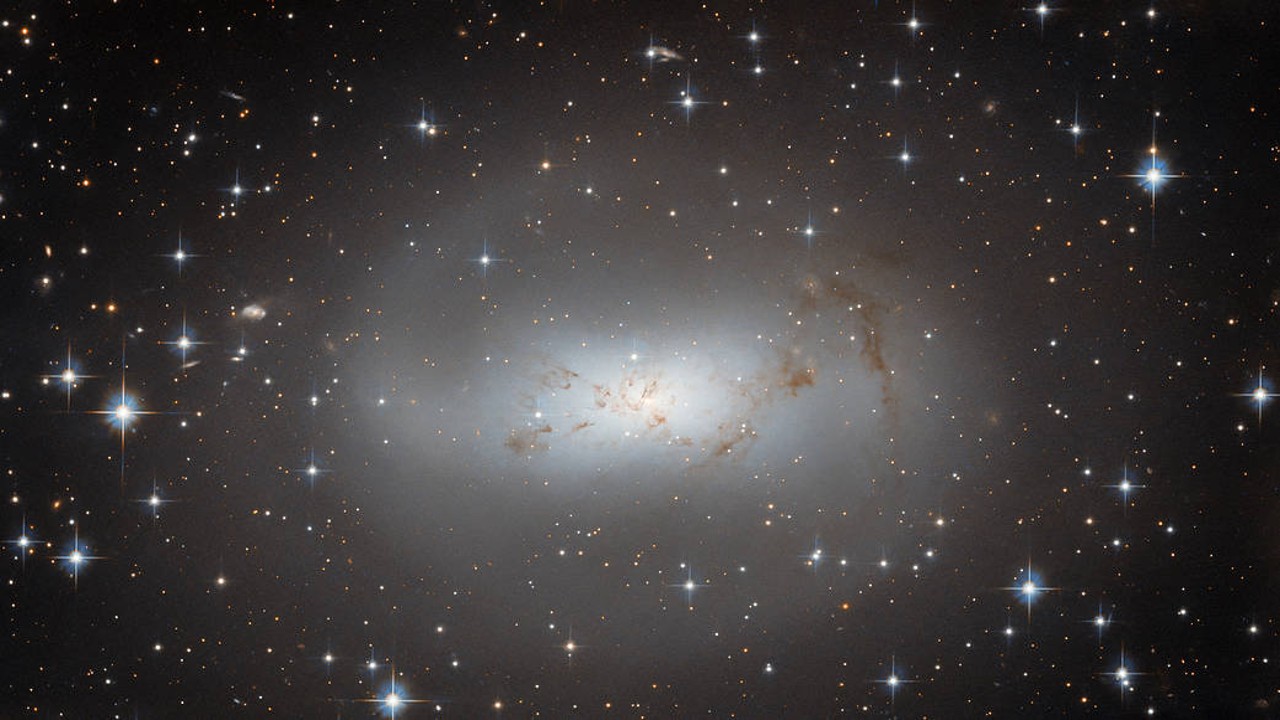Hubble telescope checks on the Milky Way galaxy's lonely neighbor (photo)
At 11 million light-years away, the galaxy is one of our nearest cosmic companions.

The Hubble Space Telescope is spying on the neighbors again.
In a newly released image, the space telescope took an extraordinarily detailed look at one of the Milky Way galaxy's closest neighbors. In the image, the irregular galaxy ESO 174–1 looks like a wispy cloud of milky white gas that is alone in space apart from a background of bright stars. Other stars can be seen within the cloud-like body of ESO 174–1, as can a dark tendril of gas and dust.
At 11 million light-years away, the galaxy ESO 174–1 is one of our nearest cosmic companions, and it was imaged by the Hubble Space Telescope as part of a program of observations that aims to better understand the galactic population of the Milky Way's surroundings.
Related: Hubble Space Telescope: Pictures, facts & history
One of the most striking differences between the Milky Way and the ESO 174–1 apparent from this image is the shapes of these galaxies. While our galaxy has a well-defined spiral shape with a central bulge of concentrated stars and spiral arms radiating out from this, the shape of ESO 174–1 is less well-ordered.
This is because it is an example of an irregular galaxy, a class of galaxies that has a wide spectrum of both shapes and sizes. Irregular galaxies can range from dwarf irregular galaxies with masses equivalent to around 100 million times that of the sun's mass to much larger galaxies with around 10 billion solar masses. The shapes of these galaxies can range from flattened spheres like ESO 174–1, to long toothpick-like galaxies, to ring-shaped galaxies.
NASA says that the odd shapes of irregular galaxies may emerge as the result of interactions between two galaxies. For instance, if two spiral galaxies pass each other, the one with the strongest gravitational influence could pull at material from the other. As it loses material, the weaker galaxy may become distorted, taking on a new shape.
Get the Space.com Newsletter
Breaking space news, the latest updates on rocket launches, skywatching events and more!
Alternatively, irregular galaxies could be created when two galaxies collide, resulting in a new, single galaxy lacking a well-defined shape. Larger irregular galaxies may also represent a step in galactic evolution between a spiral galaxy and a galactic type called an elliptical galaxy. This latter class of galaxies is also believed to be born from the merger of spiral galaxies. Elliptical galaxies are rarer than spiral galaxies and tend to have completely oval or round shapes.
The observation program that aims to capture the neighboring galaxies of the Milky Way utilizes the 2% to 3% of Hubble's time that falls between other observations. According to NASA, these gaps are necessary because it is inefficient for Hubble to make back-to-back observations of objects that are in opposite parts of the sky. It is hoped that the project will eventually resolve the brightest stars of every known galaxy within around 10 megaparsecs, or 32 million light-years, of the Milky Way. In the process, Hubble could help scientists better understand the basic characteristics of local galaxies.
Observing programs like this one let Hubble move gradually from one observation to another while still gathering data, ensuring every minute of the observing time of the space telescope is used.
Join our Space Forums to keep talking space on the latest missions, night sky and more! And if you have a news tip, correction or comment, let us know at: community@space.com.

Robert Lea is a science journalist in the U.K. whose articles have been published in Physics World, New Scientist, Astronomy Magazine, All About Space, Newsweek and ZME Science. He also writes about science communication for Elsevier and the European Journal of Physics. Rob holds a bachelor of science degree in physics and astronomy from the U.K.’s Open University. Follow him on Twitter @sciencef1rst.









